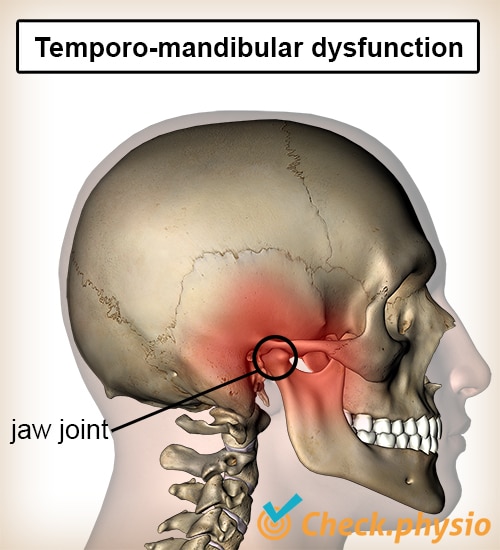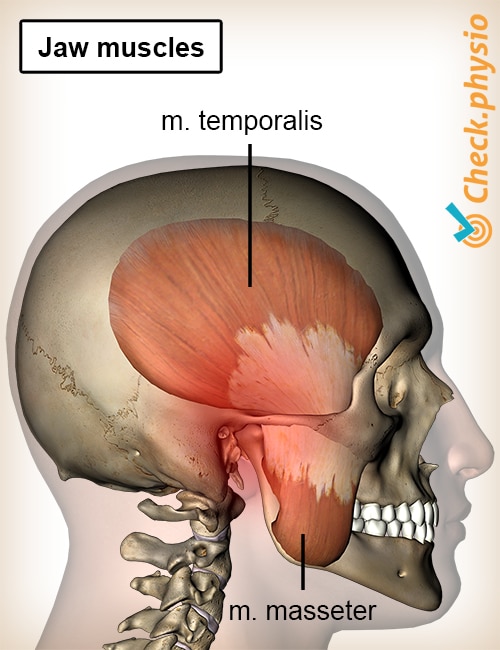Jaw disc dysfunction
Jaw popping, jaw pain, temporomandibular dysfunction
There is a disc between the moving parts of the jaw joint. This is a small disc that ensures that the moving parts can move smoothly over each other. This disc can cause problems if the jaw does not function properly. When opening or closing the mouth, a 'pop' can be felt, hence the name jaw popping.

Description of the condition
The jaw joint is formed by the skull and the lower jaw. The jaw joint is located close to the ear. The joint, like any joint, has a joint capsule to which muscles, tendons and ligaments attach.
Within this capsule is the jaw disc. This is a small disc that sits between the moving parts of the lower jaw and the skull. It ensures that the jaw joint can move smoothly and that the joint surfaces do not wear out. The disc in the jaw joint causes problems in the case of jaw popping.
The function of the jaw joint is to open and close the mouth. For this reason, the joint must be able to glide, roll and slide. If opening and closing of the mouth causes problems, the jaw joint is often the cause. The disc can cause a blockage that prevents the mouth from opening fully. The disc can also restrict the mouth from closing completely.
Popping of the jaw joint is caused by movement of the jaw joint and the disc. The end of the jaw may collide with the disc. The pop can also be caused by the disc being displaced with force.
Cause and origin
Disc problems in the jaw joint can have various causes. For example, trauma as a result of a fall on or a bump against the jaw joint. This can cause a subluxation (partial dislocation) of the jaw joint.
Complaints can also occur gradually as a result of:
- Overbite or underbite (upper and lower teeth do not fit together properly).
- Toothache.
- Tooth grinding.
- Clenching (jaws clamp together).
- Problems coming from the neck.
These are causes belonging to the myofascial pain dysfunction syndrome. This means that they cause a dysfunction of the muscles around the jaw joint. This causes the jaw to move differently and the disc to cause problems.
A disc problem without an identifiable cause, such as a fall, arises gradually and has usually already caused other jaw complaints or complaints of pain around the neck and ears.
The number, size and position of the teeth affect the jaw joint. This is because the jaw needs to adapt during growth and changing of teeth. If, for example, more teeth come through than the space allows for, this creates tension in the jaw joint. This tension can also be caused by the so-called over- or underbite. A "bite" is the relationship between the upper and lower teeth when the teeth are together. With an overbite, the upper teeth are far in front of the lower teeth, with an underbite, the lower teeth are in front of the upper teeth.
Long-term toothache can cause a different chewing pattern. In this case, one side is usually spared and the other side is overburdened. Overburdening of the jaw can also be caused by grinding or clenching. This often happens at night and people are not really aware of it.
The neck can also cause problems in the jaw. The jaw joint, close to the ear and the high cervical vertebrae, is sensitive to tension and too much or too little movement in that area.
Signs & symptoms
Symptoms of disc problems in the jaw joint are:
- Popping or clicking sensation in the jaw joint.
- Pain in the area of the ear and in the jaw region.
- Difficulty opening and closing the mouth.
- Always chewing on one side.
- Neck pain.
- Sometimes the pain radiates as a headache.
Jaw popping does not necessarily mean that you are experiencing symptoms. There are many people who regularly feel something pop in the jaw, but who are otherwise not bothered by it.
Diagnosis
Jaw disc problems are diagnosed by a dentist, physiotherapist or ENT-specialist. Based on the pattern of symptoms, the functioning of the jaw is examined to determine in which position the disc is causing problems.
Treatment
Disc problems in the jaw joint are well and relatively easy to treat by a dentist or physiotherapist. In case of the latter, a physiotherapist specialising in the jaw (a orofacial or Crafta® (Craniofacial Therapy Academy) therapist) is required.
Unfortunately, not every physician is aware that physiotherapists can treat these complaints well. Fortunately, there is increasing cooperation between dentists and physiotherapists. Together, they look at the cause and decide whether the treatment should be provided by the dentist, orthodontist or physiotherapist. Of course, this depends on the cause of the complaints.
If the cause results from dysfunctional jaw joints, trauma (accident or fall) or neck problems, the physiotherapist can treat this well. The treatment then consists mainly of mobilisation of the jaw joint and exercises. The high cervical vertebrae and all the muscles in this region are also included. Exercises are aimed at getting the muscles around the jaw joint and cervical spine to move properly again.
If the cause is the position of the teeth or an abnormality in the jaw itself, a dentist, orthodontist or oral surgeon will take over the treatment.
Exercises
You can check your symptoms using the online physiotherapy check or make an appointment with a physiotherapy practice in your area.

References
Banks, K. & Hengeveld, E. (2014). Maitlands clinical companion. An essential guide for students. Churchill Livingstone. Elsevier.
Hu, Y. K., Yang, C. & Xie, Q. Y. (2016). Changes in disc status in the reducing and nonreducing anterior disc displacement of temporomandibular joint: a longitudinal retrospective study. Sci. Rep. 6, 34253; doi: 10.1038 / srep34253 (2016).



